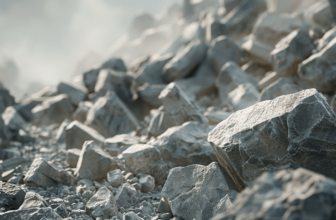Choosing the right material for your construction or landscaping project can make all the difference in its longevity, functionality, and aesthetic appeal. Two commonly used materials, crushed stone and gravel, often present a dilemma to builders and homeowners alike due to their similarities and differences. How do you navigate the options, and more importantly, how do you determine which is better suited for your project? Is it crushed stone or gravel, or does it depend on the specific circumstances? This comprehensive guide aims to shed light on these crucial materials, define their key attributes, and delve into their numerous applications.
Defining the Key Terms: Crushed Stone and Gravel
Crushed stone and gravel are both popular materials in a wide variety of construction and landscaping projects. Despite their similar uses, they differ significantly in their origin, composition, and visual appeal. Understanding these key terms—gravel vs. crushed stone—can dramatically impact your project outcome.
Understanding Crushed Stone
What is Crushed Stone?
Crushed stone, also known as crushed rock, is a product of blasting, crushing, and processing rocks into more manageable sizes. The process results in a highly versatile, powerful material perfect for various construction and landscaping applications.
How is Crushed Stone Made?
Creating crushed stone involves mining a suitable rock deposit and breaking down the rock to the desired size using crushers. It’s often composed of limestone, granite, or trap rock, depending on the quarry where it was mined.
Different Types and Sizes of Crushed Stone
Crushed stone comes in many types and sizes, which can be tailored to suit specific project requirements. The rock size usually varies from dust (or fine particles) to around 10 inches, and the type can range from limestone to granite. Each size and type has different uses, from road construction to decorative features.
Common Uses for Crushed Stone
Crushed stone is often used in construction projects like foundations, roads, and walkways. It also serves as a base material under concrete and asphalt. Crushed stone is used for drainage solutions, decorative accents, and garden edges in landscaping.
Delving Into Gravel
What is Gravel?
Gravel is a natural material that consists of water-transported particles of rock that are larger than two millimeters in diameter and usually have a rounded shape due to their water-torn journey.
How is Gravel Made?
Gravel is naturally occurring and is formed as rocks break down from weathering and erosion over millions of years. It’s extracted from gravel pits—natural deposits often found near water bodies.
Different Types and Sizes of Gravel
Gravel comes in many sizes, typically from 1/10 inch to 2.5 inches. It’s classified into various types, like bank gravel, bench gravel, creek rock, and pea gravel, each with unique properties and uses.
Common Uses for Gravel
Gravel is commonly used in landscaping and aesthetic applications. It’s used to create paths, in garden beds for drainage, or as a decorative element in rock gardens. It’s also commonly used in concrete and asphalt mixing.
Crushed Stone Vs. Gravel: The Differences
Physical and Aesthetic Differences
The primary physical difference between crushed stone and gravel is their production process and shape—crushed stone is typically more angular and jagged due to the crushing process. In contrast, gravel has a smoother, rounded shape from natural weathering. These differences affect their aesthetic appeal—crushed stone gives a more structured, edgy look, whereas gravel offers a softer, natural appeal.
Variations in Strength and Durability
In the debate of crushed stone vs. gravel, the former usually wins in terms of strength. Crushed stone is often stronger than gravel, making it an excellent choice for heavy-duty applications like driveways or foundations. Yet, gravel’s rounded and smooth surface makes it less susceptible to compaction, which can benefit drainage applications.
Differences in Cost
There’s a notable difference between crushed stone and gravel when considering the cost. Generally speaking, gravel tends to be more affordable than crushed stone, making it a popular choice for larger areas or when the price is a significant factor in decision-making. The lower cost of gravel is primarily due to its natural occurrence, requiring less processing compared to crushed stone.
On the other hand, the cost of both materials can significantly vary based on factors like size, type, and transportation. For instance, specific types of crushed stone may be more expensive due to the complexity involved in its production or its scarcity. Similarly, transporting the materials can significantly add to the overall cost, with longer distances and difficult terrain increasing expenses.
Environmental Impacts of Crushed Stone and Gravel
Environmental considerations are crucial in the crushed gravel vs. crushed stone discussion. The process of mining and crushing stone uses more energy and can cause more environmental impact than the natural process that creates gravel. Still, crushed stone is often made from more abundant, hard rocks, whereas some gravel types can be scarce depending on the area.
Choosing Between Crushed Stone and Gravel
Considerations for Homeowners
Homeowners should consider the intended use, aesthetics, and maintenance when choosing between stone vs. gravel. For example, gravel might be preferred for a more natural look or a patio with good drainage, while crushed stone might be chosen for a sturdy driveway.
Advice for Construction Projects
In construction projects, your material choice should be driven by project specifics such as durability, strength, cost, and aesthetic requirements. With its higher strength and angularity, crushed stone is typically preferred for foundational work, roads, and other heavy-duty applications. Its durability makes it ideal for projects that demand longevity and resistance to wear. On the other hand, gravel, with its smooth texture and rounded edges, is often used in concrete or asphalt mixing or areas requiring good drainage. It’s crucial to assess the demands of your project and weigh them against the properties and cost of each material to make the optimal decision.
Landscaping with Crushed Stone Vs. Gravel
Landscaping choices depend on the homeowner’s or designer’s aesthetic and practical preferences. The main difference between gravel and stone is their visual appeal and their function in the landscape. Remember, while both have advantages, your specific project requirements should guide your decision.
Bottom Line
In conclusion, the choice between crushed stone and gravel hinges on the specifics of your project and personal preferences. Both materials offer unique advantages and aesthetic appeal that can enhance the quality of your construction or landscaping project. With its angular shape and durability, crushed stone is a superb option for heavy-duty projects like foundations or driveways. On the other hand, with its smooth, rounded form, gravel is a preferred choice for decorative landscapes or areas requiring good drainage.
Understanding the nuances of these materials—their production, the differences in strength, durability, cost, or environmental impact—will empower you to make a more informed decision. The essence of the debate: gravel vs. stone is not about determining a superior material but understanding its characteristics to suit your needs.
Remember, the right material can drastically improve your project’s aesthetic and functional quality, be it a new garden path, a renovated driveway, or a building foundation. Therefore, when considering stone vs. gravel, evaluate your project needs first and let them guide your material choice.







